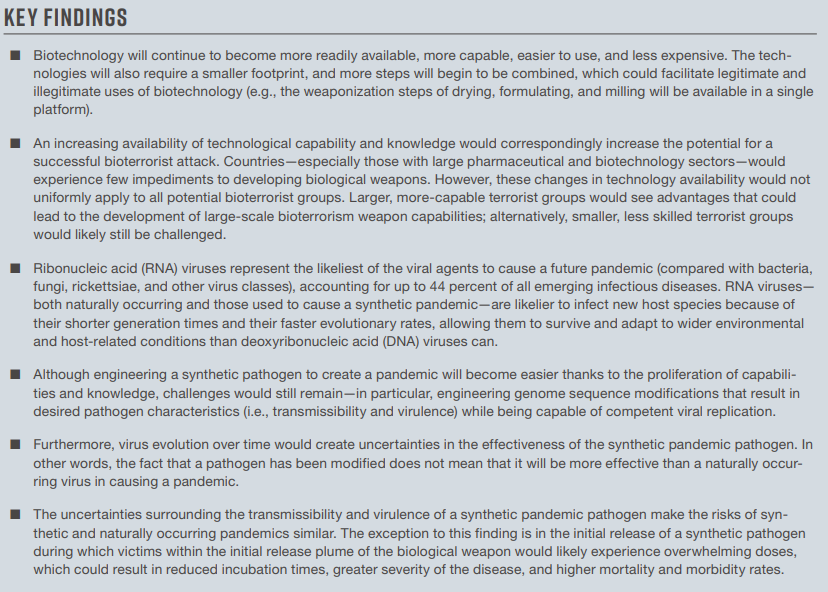The more RAND describes the motives behind a synthetic pandemic, the more they sound like COVID-19 and the great reset: perspective
The potential for synthetic pandemics and bioterror attacks is increasing as the technologies and capabilities become cheaper and more widely-accessible, according to a recent RAND Corporation report.
The RAND report “Emerging Technology and Risk Analysis: Synthetic Pandemics,” says that over the next 10 years, “More potential terrorist actors will have access to synthetic biology knowledge and capabilities,” and, “The continued proliferation of biotechnology has meant that a greater number of people understand and have access and the potential to conduct dangerous biological R&D.”
Given that “Biotechnologies that were state of the art 10 years ago are being employed by high school students studying gene synthesis and biotechnology,” today’s “biotechnology equipment is plentiful and quite affordable.”
“Advances in biotechnology and humans’ growing capacity to program the essence of life extend to the deliberate use of biotechnology to develop biological weapons (BWs), including a pathogen that could be used to cause a synthetic pandemic”

“Although skilled bioterrorist individuals, groups, and countries would be very likely to successfully develop a synthetic pathogen capable of replication and human-to-human transmission, creating a pathogen with pandemic potential would be subject to uncertainties caused by the combination of evolutionary biology pressures and random mutations”
However, developing a synthetic pathogen as a biological weapon may not lead to a full-blown synthetic pandemic, as there would still be uncertainties in how the engineered pathogen would evolve over time and whether it would become more or less transmissible or more or less virulent.
For example, a synthetic pathogen could be released on a target population with devastating initial results, but then not spread.
According to the report:
“The uncertainties surrounding the transmissibility and virulence of a synthetic pandemic pathogen make the risks of synthetic and naturally occurring pandemics similar, except in the initial release of a synthetic pathogen during which victims in the initial biological weapon release plume would likely experience overwhelming doses, which could result in reduced incubation times, greater severity of the disease, and higher mortality and morbidity rates.”
The authors make several assumptions in their report, most glaringly that COVID-19 was a naturally occurring pandemic:
“A synthetic pandemic might not result in a pandemic that is more transmissible and virulent than a naturally occurring pandemic, such as COVID-19”
But as for their risk assessment concerning the capabilities of bad actors to develop synthetic pathogens and their potential to become synthetic pandemics, the authors make three assumptions:
- A terrorist organization with state sponsorship would have few limitations on its ability to develop a synthetic pandemic pathogen or conduct a successful biological weapons attack.
- A threat actor able to bioengineer a synthetic pathogen would need some level of skill to both engineer the pathogen and perpetrate a successful biological weapons attack.
- Even being able to engineer a synthetic pathogen and perpetrate a successful biological weapons attack does not necessarily mean that a synthetic pathogen used in an initial biological weapons attack would be capable of causing a pandemic.
When talking about motives for a synthetic pathogen attack, the authors describe a scenario that looks a lot like the global response to the COVID-19 pandemic, regardless of whether you believe it was naturally occurring, came from a lab, or never existed in the first place.
For example, the report asks:
“Is the intent to create high mortality and morbidity, to create fear in the population, or to create a global window of vulnerability that can be exploited?”
Would the response to COVID-19 being declared a pandemic check all three boxes — death, fear, and a vulnerability to exploit?
Whether it was from the virus itself, the devastating results from government lockdowns, and/or certain mandated medical interventions, we continue to see high mortality and morbidity.
Creating fear in the population was the currency of governments, corporations, and unelected globalist entities that convinced people to lock themselves down in their homes, to snitch on their neighbors, to self-censor themselves online, and to become blind, obedient citizens that trust The Science™.
And the icing on the cake for COVID-19 would be the creation of “a global window of vulnerability that can be exploited.”
That is exactly the type of rhetoric used by the World Economic Forum (WEF) when it launched the great reset in June, 2020.
At the time, WEF founder Klaus Schwab specifically wrote:
“The pandemic represents a rare but narrow window of opportunity to reflect, reimagine, and reset our world to create a healthier, more equitable, and more prosperous future”
Likewise, King Charles III, who was prince at the time, said:
“We have a golden opportunity to seize something good from this crisis — its unprecedented shockwaves may well make people more receptive to big visions of change”
Then of course, we saw changes in election protocols in the United States, where mail-in ballots and drop boxes became the norm, among many other “fortifications.”
The more the RAND report describes the motives behind a synthetic pandemic, the more they sound like COVID-19 and the great reset.
Image by kjpargeter on Freepik











